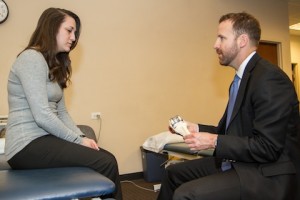-
The knee is classified as a hinge joint and is comprised of three bones: the femur, patella and tibia. The fibula, or non-weight bearing lower leg bone, is located nearby. Several muscles, tendons and ligaments support the knee joint. Each structure provides support and permits motion of the knee joint including flexion, extension and subtle rotation of the lower leg.

- The quadriceps muscle group is a set of 4 muscles located on the anterior aspect of the thigh that assist in knee extension and hip flexion. The antagonist muscle group to the quadriceps is the hamstrings; three muscles located on the posterior aspect of the thigh assisting in knee flexion.
- There are four ligaments within the knee joint. The anterior (ACL) and posterior (PCL) cruciate ligaments crossover deep within the knee and are the largest ligaments in the joint. The ACL prevents the tibia from sliding forward, while the PCL prevents the tibia from sliding backward away from the femur. The medial collateral (MCL) and lateral collateral (LCL) ligaments are found on the inside (medial) and outside (lateral) aspect of the knee respectively. They prevent the knee from bending sideways in either direction.
-
The meniscus consists of two connected semi-circular rings of cartilage located between the femur and the tibia. The menisci are located medially and laterally, providing stability as the knee bears weight and pivots. The medial meniscus is partially attached to the MCL, thus concurrent injuries in these two soft tissues often occur. There is no connection between the lateral meniscus and LCL.

- Articular cartilage is also present on the ends of the bones within the joint which acts as a cushion for the bones. Synovial fluid, or fluid within the joint, also helps to reduce friction and allows the bones of the joint to move smoothly.
- The two major tendons of the knee are connected to the patella, commonly referred to as the kneecap. The tendon inferior (below) to the patella is the patellar tendon, which connects the patella to the tibia. The tendon superior (above) to the patella is the quadriceps tendon, which connects the quadriceps muscle to the patella. The quadriceps tendon, patella and patellar tendon form a pulley system to create the extensor mechanism of the lower leg and knee.







